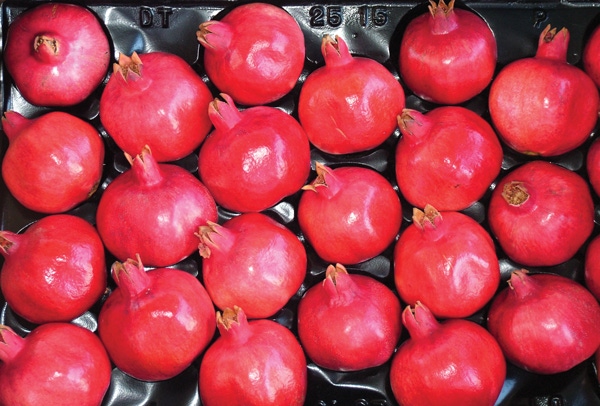
San Joaquin Valley pomegranate production has reached 30,000 acres, doubling from 2006 to 2009, and is expected to continue growing.Licensed growers, packers and marketers are expected to ship 30,000 boxes of Angel Red, a premium, soft-seeded pomegranate.Most of the 2010 Angel Red crop will go to Japan, a growing and discerning market for the California premium, bright red fruit.
October 18, 2010

Many scholars believe it was a pomegranate, rather than an apple, that tempted Adam and Eve in the Garden of Eden.
Spanish settlers introduced pomegranates to California in 1769.
Thomas Jefferson planted pomegranates at Monticello in 1771.
Pomegranates were relegated to trivia status until about a decade ago, when Los Angeles billionaires Stewart and Lynda Resnick discovered 120 acres of pomegranates tucked away in a pistachio orchard that their Paramount Farms operation had purchased.
As the story goes, in 1996 Lynda Resnick became intrigued by pomegranate medical folklore and heavily funded research to scientifically uncover the pomegranate's health effects. She has reportedly spent more than $30 million in those efforts. Some 55 papers were published. By 2000, the research was trumpeting the health virtues of pomegranate products to the world. It bolstered the Resnick’s POM Wonderful brand and other pomegranate juices and products. In addition, the research elevated pomegranates to a hot new crop — just as San Joaquin Valley producers were looking for an alternative to almonds, grapes and pistachios.
With little production other than an occasional orchard or cluster of backyard trees, pomegranates were never a popular fruit crop until the Resnicks spent their millions. It did not hurt that pomegranates are water thrifty.
They are also labor intensive to harvest and messy when split, a common malady of pomegranates in the field. You can identify anyone who has handled cracked pomegranates by the red stains on their fingers. However, the success of Resnick’s Pom Wonderful California pomegranate has minimized those drawbacks.
San Joaquin Valley pomegranate production has reached 30,000 acres, doubling from 2006 to 2009, and is expected to continue growing. Pomegranates reportedly use about a third of the water almonds and grapes need to produce a crop, a fact not lost on California farmers struggling to cope with less available water.
The latest twist in the California pomegranate story is a patented, proprietary variety discovered in Tulare County.
It is called Angel Red. This is its first season for a significant harvest. Licensed growers, packers and marketers are expected to ship 30,000 boxes of the premium, soft-seeded pomegranate to market this season. (Most pomegranate varieties are hard-seeded.) Most of the 2010 Angel Red crop will go to Japan, a growing and discerning market for the California premium, bright red fruit.
Recently, pomegranates have also been identified as a functional food in Asia where women appreciate them as a health and beauty food, just like in the U.S.
A wide range of pomegranate products have been launched throughout Asia, and pomegranate juice is rapidly gaining popularity, paralleling its ascent in the U.S.
Greg Smith, Tulare County, Calif., farmer, discovered the Angel Red pomegranate variety on one of his farms. He patented it as Smith Pomegranate and then copyrighted the name Angel Red. There are about 1,700 acres planted to Angel Red, mostly in the San Joaquin Valley. Many of the trees are less than four years old.
Monrovia Nursery is licensed to propagate Angel Red, and Sunriver Sales in Visalia, Calif., is licensed to market the new variety. Giannini Packing out of Dinuba, Calif., is the first packer licensed for Angel Red.
Smith and his partner, General Manager Chad Fjeld, a veteran fruit marketer, will license other packers as the volume grows.
At a field day in Smith’s 80 acres of pomegranates orchard near Plainview, Calif., west of Strathmore, grower Joel Atkins of Visalia said he has added 40 acres of Angel Reds to his citrus and walnut farming operation.
Bright future for pomegranates
“There has been a lot written about how healthy pomegranates are for you because of the antioxidants and all that. The future looks good for the crop. I had 40 acres of open ground and decided to plant pomegranates,” said Atkins. “I have known Greg for many years and decided to take a shot at it.
“I doubt that pomegranates will be as big as walnuts and citrus in this valley, but you never know,” he said.
Key factors in the Angel Red deal? The fruit is early, big and very red. “It actually becomes redder in the box after it is picked,” said Smith.
Smith is a veteran pomegranate grower. His family purchased the Lulu Packing pomegranate business and orchards in the early 1980s.
Angel Red came from a chance seedling Smith discovered on one of his farms in 2006. It ripens about Labor Day, which is 30 days earlier than the most popular variety in the state, Wonderful. He tested the rogue tree’s DNA and found it different than other varieties, dissimilar enough to win a patent on it.
While most Angel Red acreage is in the Central Valley, there is acreage on the Central Coast, in Southern California and Arizona. Angel Red trees have also been shipped to Peru, Chile and South Africa.
“We have a grower with 50 acres in Bowie, Ariz. Those should come off earlier than any other pomegranate. If we can get the market with an early, big, red piece of fruit, it would be to our advantage,” said Fjeld.
Smith said growers can expect to get 1.5 boxes of fresh market Angel Reds off four-year-old trees and eventually as many as two boxes per tree.
Fjeld said 200 boxes of the Angel Red were shipped to Japan last season to test the demanding market and were well received. That is why the majority of this year’s crop is earmarked for Asia. However, a specialty crop food wholesaler is distributing Angel Red in Southern California. Whole Foods in the Los Angeles area is one of the retailers handling Angel Red.
Appearance key for pomegranates
ppearance is everything with pomegranates and they must be handled gently. Smith is recommending pickers use an apple harvest belly bag and gently drop the fruit into bins with the bag’s bottom dump. Any scarring reduces the value of the fresh market fruit.
A rule of thumb is that 50 percent to 55 percent of the pomegranate fruit on a tree is harvestable for the premium, fresh market. The rest of the fruit is harvested off grade or harvested for arils or the seeds. A third marketing opportunity is the juice. However, juice prices have fallen off recently.
Removing pomegranate rind to get to the seeds is messy. A new machine from Israel separates the pomegranate arils (seeds) for the fresh market. These are packed in plastic clamshells for retailing. Smith expects soft-seeded Angel Red arils to be available next year.
Pomegranate arils can be eaten fresh, used in salads, desserts, sorbets, soups, meat sauces; or as a garnish and in sauces.
Pomegranate is also available in powder form.
Dennis McFarlin, licensed PCA with Gar Tootelian, an independent agchem and fertilizer retailer in Reedley, Calif., told growers that pomegranates are not easy to grow. He scouts about 800 acres of pomegranates in Tulare County.
Pest prevention
There are numerous, potentially devastating pests, many associated with fruit appearance. This is a key marketing element for fresh market products.
However, the pesticides registered are few. Lannate is about the only one for most pests. There is a greater choice of organic products, but they can be overwhelmed by high pest numbers.
These include aphids and whiteflies. The cotton aphid, which can build up in the fall, deposits honeydew on the fruit resulting in rotten spots on the skin. Beneficial insects often are strong enough to control aphids.
A second scientifically unidentified aphid called the “pomegranate aphid” is pale green with short, pale cornicles, different from the cotton aphid with black cornicles. This aphid infests leaves of all ages. Unfortunately, it is not controlled by beneficials.
This aphid also deposits honeydew on the fruit resulting in sooty mold.
Admire was recently registered on whiteflies in pomegranates and may control aphids applied through a drip irrigation system.
Grape and Comstock mealybugs can damage fruit, particularly the latter. Again, mealybug honeydew deposits cause fruit rot. The Encyrtidae parasites can help control these mealybugs as they do in grapes. Biological control is effective, unless disrupted by Lannate or by Grey and Argentine ants protecting the mealybugs because they feed on the honeydew.
Honeydew from citricola and black scale can also cause sooty mold, which easily is washed off. However, the green spot left when the scale is removed is often off-color because it has been covered by the scale and did not get enough sunshine to color well. Too many green spots can downgrade the fruit.
Where orchards border cotton fields, greenhouse and ash whiteflies can migrate from the cotton to the pomegranates. Again, honeydew and sooty mold result from heavy whitefly numbers. Cotton defoliation may send even larger numbers of whiteflies into pomegranates.
Omnivorous leafroller (OLR) is a common pest in many San Joaquin Valley crops. On pomegranates, the caterpillars typically carve surface grooves where two fruit touch or where the caterpillar has tied a leaf to the fruit surface. The worm can tunnel into the fruit, allowing pathogens to develop and grow in the arils with no visual, external symptoms. Damage can reach 20 percent or more.
OLR can be monitored by pheromone traps to monitor peak flights. It is the second flight that is the most problematic and likely warrants control. Checkmate OLR and NoMate OLR products are approved for confusion technique control.
A second option is a B.t. spray like Dipel or Deliver applied at least twice, at 700 to 900 degree days (seven to 10 days later) after the second flight begins.
The third OLR generation causes the most damage in late summer. B.t. sprays can be used then, if warranted.
Navel orangeworm and carob moth can occasionally be found tunneling into pomegranates, usually entering from rotten spots.
Leaf-footed plant bugs can build into large populations in pomegranates. More than 100 nymphs have been found in a single pomegranate. They especially like split fruit and can be found year-round in pomegranates.
Unfortunately, leaf-footed plant bugs have many hosts besides pomegranates.
Removal of leftover fruit could reduce overwintering populations.
False chinch bug is a threat to young trees. Dense masses of these can kill infested shoots in less than day.
They can build in weeds, especially London rocket. When weeds dry up or are mowed, nymphs move over the ground and climb up the lower part of trees. Control weeds for the first year or two and if necessary, treat weeds and infested ground with Lannate.
Cherry leafhopper, thrips and alfalfa weevil have also been found damaging pomegranates.
Finally, flat mite is a major pest because it causes leathering or ‘alligator skin’ damage, rendering the fruit unmarketable. These mites are small and difficult to monitor. Many pomegranate farmers apply one to three sulfur dust applications starting in late June as a prophylactic to ward off flat mite.
About the Author(s)
You May Also Like





